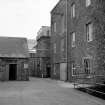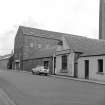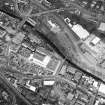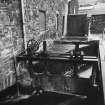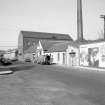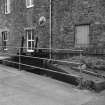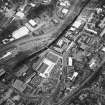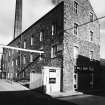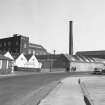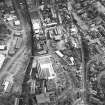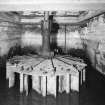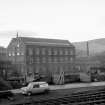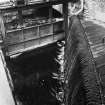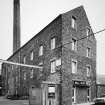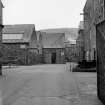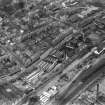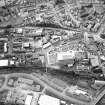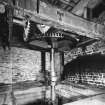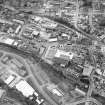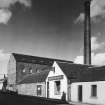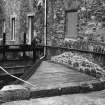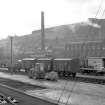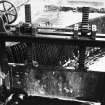Following the launch of trove.scot in February 2025 we are now planning the retiral of some of our webservices. Canmore will be switched off on 24th June 2025. Information about the closure can be found on the HES website: Retiral of HES web services | Historic Environment Scotland
Galashiels, Huddersfield Street, Abbotsford Mill
Woollen Mill (Period Unassigned)
Site Name Galashiels, Huddersfield Street, Abbotsford Mill
Classification Woollen Mill (Period Unassigned)
Alternative Name(s) Waverley Mill; Nether Mill
Canmore ID 145786
Site Number NT43NE 64
NGR NT 4954 3587
Datum OSGB36 - NGR
Permalink http://canmore.org.uk/site/145786
- Council Scottish Borders, The
- Parish Galashiels
- Former Region Borders
- Former District Ettrick And Lauderdale
- Former County Selkirkshire
NT43NE 64 495 358
NT 495 358 A programme of standing building recording was undertaken in January 2006 in advance of the demolition of the Waverley Mill; the site is to be redeveloped for large retail outlets. The work included desk-based research, photographic and metric survey and the production of a detailed and illustrated report on all the standing buildings. The development site incorporated the former Waverley Mill (also known as the Abbotsford or Nether Mill) and part of the Waverley Ironworks (demolished in the 1970s). Just SW was the site of Huddersfield Mill, founded in 1818 and demolished in the 1970s.
The Waverley Mill might have origins in the 17th century as a waulk mill, and the earliest standing building (rebuilt in 1805) is probably built on this foundation. The earliest phase of buildings on the site included this first mill and hand weaver's cottages, some of which are probably late 18th-century. By the mid-19th century the mill had been expanded, with a steam engine added and additional sheds built to house more machinery and a dye house (as more processes became mechanised). By the 1860s and 1870s, large open area weaving sheds were established, a new four-storey mill, a larger dye house and a new twin-engine house.
Much of this work was probably by Adam Stirling of Galashiels. The control of the mill was by Jason Fairgrieve in 1824, James Shaw (of Wilderhaugh Mill, Galashiels) in 1868, the British Boot Company in 1898, G and R Hunter (1903-1963) and then J Buchan and Lochcarron - the current occupiers.
The mill complex was originally hand- and water-powered. By the 1850s, the main mill, by this time fully industrial, almost certainly included a steam engine. A new engine- and boiler-house was built around 1878. This housed twin-horizontal steam engines powered by three Lancaster boilers, with an economiser behind and a tall octagonal chimney. The combination of water and steam powered the entire mill complex via a series of linear drive shafts; most of the bearing boxes and bolting faces survive, showing the complex layout. The mill switched to electric power in the 1950s. A suite of architectural drawings survives in the Scottish Borders Library Archive.
Archive to be deposited in NMRS, including digital photographs.
Report lodged with Borders SMR.
Sponsor: Terrace Hill Ltd.
George Geddes, Headland Archaeology Ltd.
Standing Building Recording (January 2006)
NT 495 358 A programme of standing building recording was undertaken in January 2006 in advance of the demolition of the Waverley Mill; the site is to be redeveloped for large retail outlets. The work included desk-based research, photographic and metric survey and the production of a detailed and illustrated report on all the standing buildings. The development site incorporated the former Waverley Mill (also known as the Abbotsford or Nether Mill) and part of the Waverley Ironworks (demolished in the 1970s). Just SW was the site of Huddersfield Mill, founded in 1818 and demolished in the 1970s.
The Waverley Mill might have origins in the 17th century as a waulk mill, and the earliest standing building (rebuilt in 1805) is probably built on this foundation. The earliest phase of buildings on the site included this first mill and hand weaver's cottages, some of which are probably late 18th-century. By the mid-19th century the mill had been expanded, with a steam engine added and additional sheds built to house more machinery and a dye house (as more processes became mechanised). By the 1860s and 1870s, large open area weaving sheds were established, a new four-storey mill, a larger dye house and a new twin-engine house.
Much of this work was probably by Adam Stirling of Galashiels. The control of the mill was by Jason Fairgrieve in 1824, James Shaw (of Wilderhaugh Mill, Galashiels) in 1868, the British Boot Company in 1898, G and R Hunter (1903-1963) and then J Buchan and Lochcarron - the current occupiers.
The mill complex was originally hand- and water-powered. By the 1850s, the main mill, by this time fully industrial, almost certainly included a steam engine. A new engine- and boiler-house was built around 1878. This housed twin-horizontal steam engines powered by three Lancaster boilers, with an economiser behind and a tall octagonal chimney. The combination of water and steam powered the entire mill complex via a series of linear drive shafts; most of the bearing boxes and bolting faces survive, showing the complex layout. The mill switched to electric power in the 1950s. A suite of architectural drawings survives in the Scottish Borders Library Archive.
Archive to be deposited in NMRS, including digital photographs.
Report lodged with Borders SMR.
Sponsor: Terrace Hill Ltd.
G F Geddes 2006

































